General Information
Cooperation projects 2021–2023Promoting UNESCO biosphere reserves in Southern Africa
What is the MAB Programme?
UNESCO biosphere reserves are the main instrument of the MAB Programme. These protected areas are model regions for sustainable development. They promote interdisciplinary approaches to reconcile the conservation of biological diversity with its sustainable use by people.
Model Regions for Sustainable Development Fostering UNESCO biosphere reserves in Southern Africa
- Exchange of knowledge and experience in the region
- Establishment of new biosphere reserves
- Quality assurance and improvement of already designated biosphere reserves
- Empowerment of youth and local communities and strengthening of research activities
Exchanging knowledge and experiencesThe Regional MAB Workshop
Botswana
Namibia
Simbabwe
Zambia
Becoming a UNESCO biosphere reserve
Malawi
Dealing with natural disasters
South Africa
Strengthening the South African Youth Network
Mozambique
Introducing “Environmental Clubs” in primary schools in the Quirimbas Biosphere Reserve
Lesotho
Building management structures in Mat’seng Biosphere Reserve
Eswatini
Engaging with local communities
Cooperation Projects in 2023
Cooperation project 2023Malawi: Dealing with natural disasters
South Africa
Cooperation project 2023South Africa: Strengthening the Youth Network
Magaliesberg Biosphere ReserveBiosphere reserves and Youth Networks
Raising young people's awareness of such a manifold environment and the related issue of sustainability is one of the priorities of UNESCO biosphere reserves. For this reason, the MAB Programme places particular emphasis on strengthening national youth networks.
Developing a communication kit for different target groups
Mozambique
Cooperation project 2022Mozambique: Introducing “Environmental Clubs” in primary schools in the Quirimbas Biosphere Reserve
Impressions of the Quirimbas Biosphere Reserve
Implementation of the Environmental Clubs in the districts Meluco, Antuabe and Metuge
Experts presented the project idea to district government representatives and school principals. Six primary schools were then selected to take part in the project and set up an “environmental club” at their school.
Teaching material
material and descriptions
of “environmental clubs”
Cooperation Projects in 2021
Cooperation project 2021Zambia: Becoming a UNESCO biosphere reserve
First impressions of Kafue Flats Biosphere Reserve
Gaining the support of local chiefs
With the support and input of all eight participating chiefs, the MAB Task Team completed the nomination dossier and submitted it to UNESCO. This approach has led to the active involvement of the local communities and contributed to the promotion of sustainable development in the area.
Informing local communities via radio shows
Local radio stations are an excellent means of reaching people in the biosphere reserve areas, as they are a popular news medium in Zambia.
Radio Clip 1Introducing the Kafue Flats Biosphere ReserveA small impression of the radio programme
Radioclip 2Sharing the benefits with the communityExperts share insights on innovative practices such as solar energy and fish farming
Building Management Structures
Cooperation project 2021Lesotho: Building management structures in Mat´seng Biosphere Reserve
Building management structures in Mat’seng Biosphere Reserve
The MAB Committee is responsible for setting up management structures and implementing activities to meaningfully involve local communities. This ensures the quality of the biosphere reserve in the long term.
First impressions of Mat’seng Biosphere Reserve
Training of local MAB Ambassadors
Enganging the community
Cooperation project 2021Eswatini: Engaging with local communities
Conducting community-needs-assessments
The Eswatini Department of Statistics analyzed the data, and the traditional authorities used it to develop community projects tailored to their specific needs and requirements.
Example of community projectsTraining local tour guides for sustainable tourism
Participants also had the opportunity to pitch their own tour guiding business ideas to a jury. The top three proposals received additional support and resources to set up their tour guiding programs. The project aimed to develop the Lubombo Biosphere Reserve as a hub for sustainable tourism, contributing to the economic growth of the community.
Voices of our partners
Voices of our partnersPromoting research and youth engagement in biosphere reserves
Dr Marlene ChikuniHow important is research for biosphere reserves?
Dr Portia ChifambaHow important are research institutions for biosphere reserves?
Monica MagxwalisaCan research be a tool for engagement?
Matsooana SekokotoanaA biosphere reserve has been designated… what next?
Vongani MaringaHow have countries addressed the need for further guidance?
Tonderai MakoniThe involvement of youth in biosphere reserves
Further readings

More information can be found on these websites:






























































































































 Promoting UNESCO biosphere reserves in Southern Africa
Promoting UNESCO biosphere reserves in Southern Africa
 What is the MAB Programme?
What is the MAB Programme?
 UNESCO biosphere reserves
UNESCO biosphere reserves
 UNESCO biosphere reserves
UNESCO biosphere reserves
 The network of biosphere reserves in Southern Africa
The network of biosphere reserves in Southern Africa
 Fostering UNESCO biosphere reserves in Southern Africa
Fostering UNESCO biosphere reserves in Southern Africa
 Exchanging knowledge and experiences
Exchanging knowledge and experiences
 Malawi: Dealing with natural disasters
Malawi: Dealing with natural disasters
 Analysing the impact of the cyclone
Analysing the impact of the cyclone
 Implementing early warning systems and rebuilding settlements
Implementing early warning systems and rebuilding settlements
 Involving young people
Involving young people
 South Africa: Strengthening the Youth Network
South Africa: Strengthening the Youth Network
 Biosphere reserves and Youth Networks
Biosphere reserves and Youth Networks
 Developing a communication kit for different target groups
Developing a communication kit for different target groups
 Capacity building activities to train young people
Capacity building activities to train young people
 Positive outcome of the project
Positive outcome of the project
 Mozambique: Introducing “Environmental Clubs” in primary schools in the Quirimbas Biosphere Reserve
Mozambique: Introducing “Environmental Clubs” in primary schools in the Quirimbas Biosphere Reserve
 Impressions of the Quirimbas Biosphere Reserve
Impressions of the Quirimbas Biosphere Reserve
 Implementation of the Environmental Clubs in the districts Meluco, Antuabe and Metuge
Implementation of the Environmental Clubs in the districts Meluco, Antuabe and Metuge
 Trainings at schools: Everybody can make a difference!
Trainings at schools: Everybody can make a difference!
 Teaching material
Teaching material
 Posters for the usage in schools
Posters for the usage in schools
 Positive outcome of the project
Positive outcome of the project
 Zambia: Becoming a UNESCO biosphere reserve
Zambia: Becoming a UNESCO biosphere reserve
 First impressions of Kafue Flats Biosphere Reserve
First impressions of Kafue Flats Biosphere Reserve
 Gaining the support of local chiefs
Gaining the support of local chiefs
 Informing local communities via radio shows
Informing local communities via radio shows
 Introducing the Kafue Flats Biosphere Reserve
Introducing the Kafue Flats Biosphere Reserve
 Sharing the benefits with the community
Sharing the benefits with the community
 Local chief endorsement and community feedback
Local chief endorsement and community feedback
 Lesotho: Building management structures in Mat´seng Biosphere Reserve
Lesotho: Building management structures in Mat´seng Biosphere Reserve
 Building management structures in Mat’seng Biosphere Reserve
Building management structures in Mat’seng Biosphere Reserve
 First impressions of Mat’seng Biosphere Reserve
First impressions of Mat’seng Biosphere Reserve
 Stakeholder project kick-off meeting
Stakeholder project kick-off meeting
 Training of local MAB Ambassadors
Training of local MAB Ambassadors
 Production of information materials
Production of information materials
 Eswatini: Engaging with local communities
Eswatini: Engaging with local communities
 Conducting community-needs-assessments
Conducting community-needs-assessments
 Training local tour guides for sustainable tourism
Training local tour guides for sustainable tourism
 Community market to support families
Community market to support families
 Voices of our partners
Voices of our partners
 How important is research for biosphere reserves?
How important is research for biosphere reserves?
 How important are research institutions for biosphere reserves?
How important are research institutions for biosphere reserves?
 Can research be a tool for engagement?
Can research be a tool for engagement?
 A biosphere reserve has been designated… what next?
A biosphere reserve has been designated… what next?
 How have countries addressed the need for further guidance?
How have countries addressed the need for further guidance?
 The involvement of youth in biosphere reserves
The involvement of youth in biosphere reserves
 Further readings
Further readings